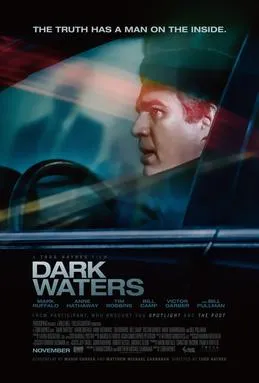Historical accuracy of Dark Waters

Historical accuracy of Dark Waters

Characters
Robert Bilott
Robert Bilott is the real-life lawyer who took on DuPont. The film accurately portrays his background and his central role in the decades-long legal battle.
Sarah Barlage Bilott
Sarah Barlage Bilott is Robert Bilott's real wife, also a lawyer. The film accurately depicts her presence and support during the protracted case.
Tom Terp
Tom Terp was a real senior partner at Taft Stettinius & Hollister who supported Bilott's case against DuPont, a major client of the firm.
Phil Donnelly
This character appears to be a composite based on several DuPont executives and lawyers. While representing DuPont's stance, specific actions and dialogue may be dramatized or invented.
Harry Deitzler
Harry Deitzler is a real trial lawyer from West Virginia who collaborated with Bilott on the personal injury cases against DuPont.
Darlene Kiger
Darlene Kiger and her husband Joe were real residents whose concerns about PFOA in their water led them to become lead plaintiffs in the class action lawsuit.
More characters
Joe Kiger
Joe Kiger and his wife Darlene were real residents who became key plaintiffs in the class action suit after discovering PFOA in their drinking water.
Jim Tennant
Wilbur's brother, Jim Tennant, was a real person who worked at DuPont and suffered from unexplained illnesses. DuPont bought part of the family land Jim lived on.
James Ross
This character, who expresses concerns about the lawsuit appearing like a "shakedown," seems to be an invented figure representing potential internal opposition or skepticism at the firm.
Story
Farmer Tennant's cattle mysteriously dying
Wilbur Tennant did contact Rob Bilott because hundreds of his cows were dying from unknown causes, which he documented on video tapes shown in the film.
DuPont knowingly dumped PFOA (C8) sludge
Investigation revealed DuPont dumped thousands of tons of PFOA sludge in a landfill upstream from Tennant's farm and discharged it into the Ohio River.
DuPont concealed PFOA health risks for decades
Bilott's discovery process uncovered internal DuPont documents showing the company knew about PFOA's toxicity and presence in workers' blood since the mid-20th century.
Bilott switches from corporate defense lawyer
Robert Bilott worked primarily for corporate clients, including chemical companies, before taking Tennant's case against DuPont.
PFOA contaminated drinking water supplies
The investigation confirmed PFOA from DuPont's Washington Works plant contaminated the drinking water for tens of thousands of people in Ohio and West Virginia.
Class action lawsuit filed (Leach v. DuPont)
Bilott filed a class action lawsuit in 2001 on behalf of ~70,000 people exposed to PFOA in their drinking water.
Creation of C8 Science Panel
A key part of the 2004 class action settlement was the creation of an independent scientific panel to study PFOA's health effects on the affected population (funded by DuPont).
PFOA linked to specific diseases
After seven years, the C8 Science Panel found probable links between PFOA exposure and six diseases: kidney cancer, testicular cancer, thyroid disease, high cholesterol, ulcerative colitis, and pregnancy-induced hypertension.
$671 million settlement for injury cases (2017)
Following the science panel's findings, Bilott pursued individual injury claims, leading DuPont to settle over 3,500 cases for $671 million in 2017.
Bilott suffered health problems during case
The film accurately depicts Bilott experiencing stress-related health issues, including stroke-like symptoms diagnosed as "unusual brain activity" around 2010.
DuPont executive insults Bilott ("Fuck you, hick")
This specific confrontational scene and insult directed at Bilott by the composite character Phil Donnelly appears to be a dramatic invention for the film.
Wilbur Tennant died before case resolution
Both Wilbur Tennant and his wife contracted cancer and passed away before the final settlements of the personal injury lawsuits were reached.
Use of Teflon-laced cigarettes in experiments
The film mentions, and sources confirm, DuPont conducted experiments in the 1960s involving employees smoking Teflon-laced cigarettes to study potential health effects.
Depiction of Bilott drinking due to stress
The film shows Bilott drinking, but associate Harry Deitzler stated he didn't recall Bilott drinking much, suggesting this aspect might be exaggerated for dramatic effect.
Decades-long duration of the legal fight
The film accurately portrays the immense timespan, from Tennant approaching Bilott in 1998 through the major settlements in 2017, and ongoing related litigation.
Setting
Time Period (Late 1990s - 2010s)
The film accurately spans the actual timeline of the events, beginning with Wilbur Tennant's approach to Bilott in 1998 and covering developments into the mid-2010s.
Locations (Cincinnati, OH; Parkersburg, WV)
The film is set and was partially filmed in the actual key locations where the events unfolded: Cincinnati (Bilott's law firm) and Parkersburg (DuPont plant, community).
Depiction of Taft Law Firm environment
The film portrays the atmosphere, pressures, and internal dynamics of a large corporate law firm like Taft Stettinius & Hollister dealing with a controversial case.
Depiction of Parkersburg community
The film effectively shows the impact on the West Virginia community reliant on DuPont economically but suffering health consequences from its pollution.
Visual representation of the era
Costumes, vehicles, technology, and general aesthetics accurately reflect the progression from the late 1990s through the 2000s and into the 2010s.
Atmosphere of corporate resistance
The film accurately conveys the legal tactics, delays, and resistance employed by DuPont throughout the lengthy litigation process described in source materials.
Focus on Ohio River Valley pollution
The contamination of the Ohio River and surrounding water sources by PFOA from the Washington Works plant is the central, factual environmental issue depicted.
